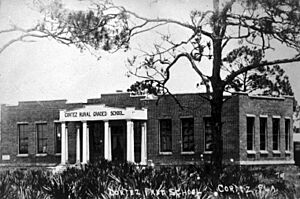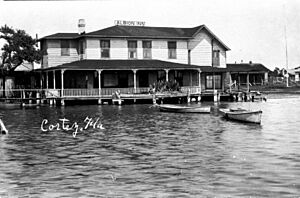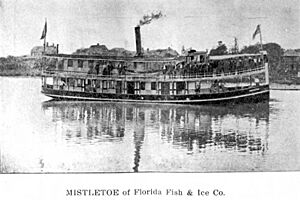Florida Maritime Museum facts for kids
| Lua error in Module:Location_map at line 420: attempt to index field 'wikibase' (a nil value). | |
| Location | 4415 119th Street West Cortez, Florida |
|---|---|
| Type | Maritime museum |
The Florida Maritime Museum is a cool place to learn about Florida's history with the sea. It's located in a historic fishing village called Cortez, Florida. The museum is sponsored by Manatee County and sits on almost 4 acres of land. It's open most weekdays and some Saturdays, so you can plan a visit!
The museum shares many stories about Florida's maritime past. You can see old photos, boat models, and tools. There are also other historic items on display. The museum has a huge collection of shells from the Gulf of Mexico. It also has a special library for research. This library holds books, old letters, and records about Florida's sea history.
The main museum building is an old schoolhouse from 1912. Other historic buildings are also on the museum grounds. These include the 1890 Burton/Bratton Store and the 1907 Pillsbury Boatshop. There's even an old wooden cistern.
Contents
What the Museum Does
The Florida Maritime Museum has an important job. It collects, keeps safe, and shares old knowledge. It also preserves cultural items and personal stories. All these things are about Florida's fishing and sea heritage.
Historic Buildings and Gardens
The Florida Maritime Museum is on almost 4 acres of land. This area has gardens with native plants and fountains. There's also a chickee hut and historic buildings. You can find old maritime objects here too. The museum grounds are open to everyone from morning until night.
The 1912 Cortez Rural Graded Schoolhouse
The Cortez Rural Graded Schoolhouse was built in 1912. It was one of six schools Manatee County built that year. This school replaced an older, smaller one-room building. The school first had three rooms: two classrooms and an office.
In 1933, the school was changed. The middle office room became a large auditorium with a stage. This made the building look like a "T" shape. It was used as a school until 1961. After that, an art school used it for a while.
In 1974, a master weaver named Robert Sailors bought the building. He turned the old classrooms and auditorium into his studios and home. Sailors lived and worked there until he passed away in 1995. Manatee County bought the property in 1999. They carefully fixed up the building. In 2007, it opened as the Florida Maritime Museum. The Cortez Schoolhouse is now a part of the National Register of Historic Places.
Robert Sailors' Gardens
Robert Sailors bought the schoolhouse in 1974. He made the property his art studio and home. Sailors added two patios outside the schoolhouse. One patio has a cool water sculpture made of blue tiles and colored glass. Today, the museum takes care of this water sculpture. They also look after other sculptures around the grounds.
The 1890 Burton/Bratton Store
In the 1890s, William C. Bratton built the first business building in Cortez. Back then, the area was called Hunter's Point. This building was a post office, a general store, and a steamboat dock. It helped connect the fishing families of the village to the outside world.
In 1900, rooms were added, and it became an inn called the Albion Inn. The inn grew over time. The Albion Inn and the 1912 Cortez Schoolhouse helped people during the big 1921 Tampa Bay hurricane in 1921. They gave shelter to villagers who lost their homes.
The inn closed in 1974. The United States Coast Guard bought the property. But the Cortez Village Historical Society and F.I.S.H. worked hard to save the store. They stopped it from being torn down in 1991. It was moved to the museum site in 2006. After being fixed up, the old store reopened in 2018. It is now part of the Florida Maritime Museum. Today, it holds museum collections upstairs and offices downstairs.
Pillsbury Boat Shop
Edward Ithamar Pillsbury started the Snead Island Boat Works in 1907. This boat shop was the first building there. It was named after his son, Asa Harmon Pillsbury. As more boats were needed, more buildings were added. The original shop became a machine shop. It held tools for working with metal.
The property was sold in the 1930s. The Pillsburys moved the shop three miles away to their home. It was still used as a machine shop there. It helped repair equipment for the Pillsbury dredging company. In 2007, the historic boat shop was moved again. It traveled from Palmetto, Florida to the Florida Maritime Museum in Cortez. A sheriff's escort helped it get there safely.
Anchor of the Steamship 'Mistletoe'
The museum grounds have a large anchor from a steamship called the 'Mistletoe.' This steamship was owned by a fisherman from Tampa, Florida, named John Savarese. It regularly carried people and goods from Tampa to Sarasota, Florida. The 'Mistletoe' also stopped in places like Bradenton, Florida and Cortez.
In 1910, the steamship sank during a hurricane. But it was raised and fixed up shortly after. In 1911, it was renamed 'The City of Sarasota.' It kept carrying people and cargo until 1917. The Pillsbury Boat Works bought the steamship. They turned it into a barge for a short time. Later, they pulled it ashore and burned it.
Marine Railway Winch
The museum grounds also have a marine railway winch. This machine was used to pull large boats out of the water. It would move them onto a repair station or dry-dock. The winch has a special carriage that connects to a support frame. This frame can adjust to fit the shape of the boat.
A cable loop goes from a pulley underwater. This loop connects to the winch. A remote control unit activates the winch. This winch was used in the local area until the late 1980s. Its last location was the Rivertown Boatworks. That was on the Manatee River in Bradenton.
Museum Collections
The museum has many interesting collections. These help us understand Florida's maritime past.
The Blake Banks Collection
Captain Blake Banks was a successful fisherman from Cortez. He loved sea life very much. His collection is very important for learning. All his specimens were found in the Gulf of Mexico. His wife, Betty, later gave some to the Florida Maritime Museum. Researchers and volunteers at the museum are making a chart. It shows where these sea creatures were collected.
Ship Models
Many models at the Florida Maritime Museum are small versions of real ships. These ships were important in Florida's sea history. They show how boats looked and worked long ago.
Maritime Library
The Florida Maritime Museum has a small library. It has books about many sea topics. These range from old Florida stories to how to build boats. The library also has boat plans and old maps. These materials are available for people doing research.
The Folk School
The Folk School started in January 2017. It helps the Florida Maritime Museum do even more. It offers hands-on classes. These classes teach and keep alive classic skills. They also help people share stories and build community. This helps everyone appreciate the history of Cortez and the areas around it.
See Also




